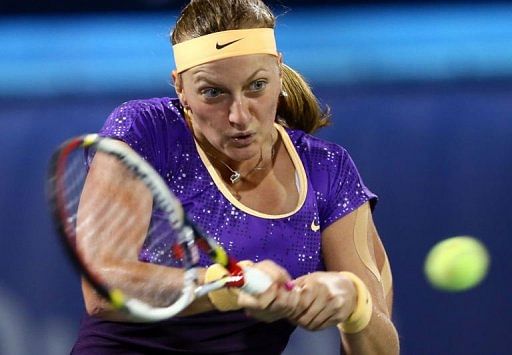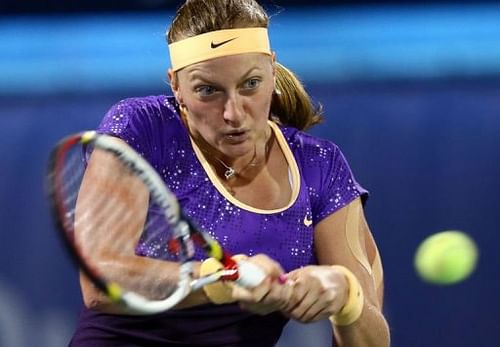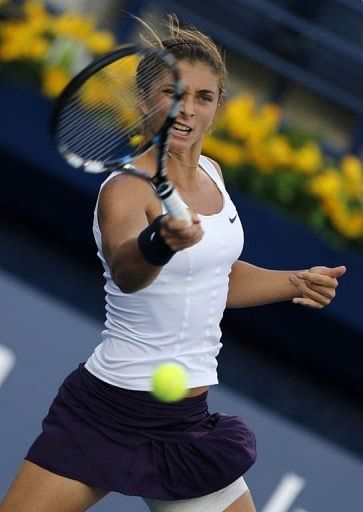
Kvitova beats another champion to reach Dubai final
DUBAI (AFP) –

Czech Republic’s Petra Kvitova returns the ball to Denmark’s Caroline Wozniacki during their WTA Dubai Open semi-final tennis match in the Gulf emirate on February 22, 2013. Kvitova won the match 6-3, 6-4.
Former Wimbledon champion Petra Kvitova, showing her best form for more than a year, beat her second champion in a row to reach the Dubai Open final here on Friday.
Kvitova, who ended the title defence of Agnieszka Radwanska on Thursday, beat the 2011 titleholder Caroline Wozniacki, breaking serve in the opening game and rarely looking back in a 6-3, 6-4 win.
In her first final in six months, she now meets fifth seed Sara Errani of Italy, the French Open finalist, who beat her best friend and doubles partner Roberta Vihnci 6-3, 6-3.
The Czech’s win over the Dane was full of characteristically fierce ground strokes, struck flat and hard to read, as well as a rising buoyancy which has not been evident over the past year.
Kvitova was delighted to have beaten three top 12 opponents in a row and, beaming at her success, said she was hopeful about her strengthened physical condition despite claiming that her “body was confused”.
Asked for an explanation, she said: “I’m trying to be stronger in my legs and to have like stronger muscles, so I can be more quicker and stay quite low for the fast shots.
“That’s something I didn’t like doing in the past. But I’m still thinking about the bad position I had before, and I’m trying to have the good position – that’s why I’m, like, quite confused.”
Nevertheless there was definite improvement in her movement, which helped her to break Wozniacki’s serve in the opening game, to keep up a fierce attack, and to hold right through to the penultimate game of the first set when she broke Wozniacki again.
Wozniacki often moved superbly, but in the second set she also tried to serve harder, play faster, and generate more pressure of her own.
This helped her break for 3-2, and save break points in the eighth game. In between these two moments of resistance however Kvitova’s attack was still too forceful, and she broke back for 3-3, and then broke again to win the match.

Italy’s Sara Errani returns the ball to her compatriot Roberta Vinci during their semi-final tennis match of the WTA Dubai Open in the Gulf emirate on February 22, 2013. Errani won 6-3, 6-3.
There was a frustrating end for Wozniacki, whose final shot, a backhand drive, was questionably called out – but she could do nothing about it because she had used up all her challenges.
“I don’t know (if it was out) but it would have been nice to be able to challenge it,” she admitted. “It was close, but, you know, I just have to believe it was out.”
If Errani and Vinci thought that by taking a break from doubles to play singles only, they would spend time apart it was not entirely successful.
Instead Errani and Vinci found themselves battling against each other for an hour and 23 minutes of old-style rallies in which slice and accurate placement played a bigger part than power and flailing topspin.
Errani prevailed because she imposed her busy approach on the rallies. However it was noticeable that she toned down her some of her grunts, suggesting that comradeship may occasionally have vied with competitiveness for priority.
“It’s tough to play against one person who knows what you’re going to do with every shot,” she admitted of the partner with whom she says she spends 300 days a year, while Vinci described it as like “playing against a sister.”
The match finished with a symbolic moment. As Errani’s drive landed near the baseline, Vinci surprisingly stopped the rally, called for a computer review, and, on seeing that the shot was shown to be in, discovered she had inadvertently ended the contest without striking the ball back against her friend.